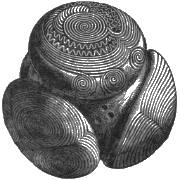NMS Archaeology Object 128718: X.EA 19 - Pottery / cinerary urn
Description
Summary
Cinerary urn, from Eglinton Castle, Kilwinning, Ayrshire
Accession Number
X.EA 19
Other references
| Not recorded | 1846 |
|---|
Original description
CINERARY URNS OF CLAY: Urn, 7 x 6 in., from a tumulus near Eglinton Castle, Ayrshire. Trevor Cowie notes, 8 January 2013: there are some grounds for associating this vessel with the remains of the Bronze Age cairn known as ‘King Coil's Grave’, located at Coilsfield Mains near Tarbolton in south Ayrshire, where it occupies the crest of a prominent W-facing rise at c.91m OD (NS 4479 262; NGR: NS42NW 11). Today, the cairn has been reduced to an oval stony mound measuring 14m from N to S by 12m and 0.5m. in height, but antiquarian accounts suggest that it was formerly more substantial. The burial mound was opened in May 1837, when the centre of the mound was found to be occupied by boulders, some of considerable size. A circular flagstone about 3 feet in diameter was encountered at a depth of about 4 feet. Under this was a quantity of yellow clay, then a small flagstone laid horizontally which covered the mouth of an urn filled with burnt bones. In removing the clay surrounding the urn, several small heaps of bones were found under flat stones, surrounded by the clay. Several other urns were found, but these disintegrated at the time. The urns were plain apart from an edging or projecting part 1/2inch from the top, and were flower-pot shaped. The largest was said to be 7 7/8inches in height and the same in diameter. ‘Pieces of ancient armour and fragments of bones’ were said to have been ploughed up at the site many years previously; their significance is now unknown and the reference to 'ancient armour' should not be taken too literally. The urn from the central burial found in 1837 was taken to Eglinton Castle and may well have been one of the 'three ancient Urns of baked clay, very much broken, found in the neighbourhood of Eglington Castle' which were presented to the Society of Antiquaries of Scotland in 1846. The catalogue of the National Museum of Antiquities of Scotland (1892) mentions one urn (NMS: EA19) 'from a tumulus near Eglinton Castle'. The size and description of the urn from ‘King Coil's Grave’ approximates to the vessel formerly in Eglinton Castle, and in the absence of any other records of burials around Eglinton Castle, they likely to be one and the same vessel. Although geographically distant, Coilsfield appears to have been part of the Eglinton estate (cf Montgomerie family links). When 'King Coil's Grave' acquired its name is unknown but is likely to be the product of much later local folk traditions. Keeping fact and legend quite separate, the site was clearly a Bronze Age burial monument, containing a number of cremation burials, at least some of them in urns, and probably dating from the period between about 2000 and 1500 BC.
Associated person/people (e.g. excavator/former collection)
None
Discovery / field collection
Date of discovery
Not recorded
Method (e.g. excavation)
Not recorded
Place (i.e. location of discovery)
Eglinton Castle, Kilwinning, Ayrshire, Scotland, Northern Europe
Grid reference
Not recorded
Acquisition
Acquisition date
1846
Acquisition source (i.e. name of donor)
Charles Lamb
Acquisition source role (e.g. donor)
Donor
Image
Identifiers and Links to Other Records
This record has no links! Would you like to help?
| Identifier / External Link | Linked Record | Status | Comment |
|---|---|---|---|
| NMS Accession Number: X.EA 19 | No linked record | Identifier supplied by NMS |
This area is visible only to logged in users.
